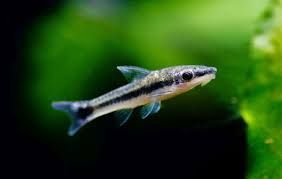Otocinclus Affinis
Otocinclus affinis, commonly known as the Otocinclus Catfish or Oto, is a small, peaceful, and excellent algae-eating fish that is perfect for keeping in planted aquariums. These fish are beloved by hobbyists for their algae-eating abilities and calm nature, making them ideal tankmates for community tanks. Here’s a complete care guide for Otocinclus affinis:
Otocinclus affinis Care Guide
1. Tank Setup
-
Tank Size: Otocinclus are small, peaceful fish and do well in tanks as small as 10 gallons (38 liters). However, a 20-gallon (75 liters) or larger tank is ideal if you plan to keep multiple Otos or a community tank with other species.
-
Aquascaping: They thrive in planted tanks with lots of live plants, such as Java Moss, Anubias, and Cryptocoryne. Live plants provide both food (in the form of biofilm and algae) and hiding spots for the Otos, as they can be shy.
-
Substrate: A soft substrate (like fine gravel or sand) is preferred since Otos sometimes scavenge along the bottom. Sharp or rough substrates can injure their delicate barbels.
-
Water Temperature: Otocinclus are tropical fish and prefer a temperature range of 22°C to 28°C (72°F to 82°F). They need stable temperatures, so avoid significant fluctuations.
-
Water pH: Otocinclus prefer slightly acidic to neutral water. Aim for a pH between 6.0 and 7.5.
-
Water Hardness: They thrive in soft to moderately hard water (5-15 dGH). Soft water is best for their overall health.
-
Filtration: Otocinclus require clean, well-oxygenated water with moderate filtration. A gentle filter (such as a sponge filter) works best because strong currents can stress them. Proper aeration is important, as Otos are sensitive to low oxygen levels.
2. Diet
-
Algae Eaters: Otocinclus are primarily herbivores and are excellent algae eaters. They graze on green spot algae, hair algae, biofilm, and other forms of algae that develop naturally in the tank.
-
Supplementing Their Diet: While Otocinclus are great at controlling algae, it’s important to supplement their diet to ensure they get all the nutrients they need, especially if algae is scarce:
-
Blanched vegetables such as zucchini, spinach, cucumber, or peas are a great addition.
-
You can also feed them algae wafers or spirulina tablets designed for bottom-dwelling fish.
-
Freshwater microalgae or dried algae can be used as a supplement as well.
-
-
Feeding Frequency: Otocinclus are grazers, so feed them small portions once or twice a day. They will actively search for algae, so try to avoid overfeeding them.
-
Overfeeding: Overfeeding can cause poor water quality and health problems, so ensure that the fish consume their food within a few minutes.
3. Tank Mates
-
Peaceful: Otocinclus are peaceful and non-aggressive, making them perfect for community tanks. They do well with other small, non-aggressive species that don’t compete heavily for food.
-
Good Tankmates:
-
Tetras (e.g., Neon Tetras, Rummynose Tetras)
-
Rasboras (e.g., Harlequin Rasboras)
-
Guppies, Endlers, or Livebearers
-
Corydoras Catfish (non-aggressive species)
-
Small peaceful plecos (e.g., Bristlenose Plecos) that won't compete with the Otos for food.
-
-
Avoid Aggressive Fish: Otos are delicate and should not be kept with large or aggressive fish that may stress or harm them, such as Cichlids, Barbs, or larger Characins.
-
Ideal Group Size: Otocinclus are social fish that should be kept in groups of 3–6 or more. They feel much safer and more comfortable in a group.
4. Behavior
-
Social and Active: Otocinclus are active but peaceful fish. They tend to swim in small groups, often sticking to the lower and middle levels of the tank. They are excellent algae eaters and can often be seen grazing on rocks, plants, and decorations.
-
Shy and Sensitive: Otos are a bit shy by nature. They may hide at first when introduced to a new tank or new tankmates, but once they acclimate, they are typically very peaceful. They do best in a tank where they feel secure and have places to hide.
-
Jumping Risk: While not known for jumping, Otocinclus can become stressed if their environment isn’t ideal. Be sure to cover your tank to prevent any accidental escapes.
5. Water Quality & Maintenance
-
Ammonia and Nitrites: Like all fish, Otocinclus are very sensitive to ammonia and nitrites, which should always be at 0 ppm. Regular water changes (about 20–30% weekly) will help maintain good water quality and remove excess waste.
-
Nitrates: Keep nitrate levels under 20 ppm. Otocinclus are sensitive to elevated nitrates, so keeping their tank clean and well-maintained is crucial for their health.
-
Filtration and Aeration: These fish need well-oxygenated water. A gentle filter with good circulation and proper aeration is important, especially in a planted tank with live plants.
-
Water Stability: Sudden changes in temperature, pH, or water quality can stress Otocinclus. Aim to keep water conditions as stable as possible.
6. Health & Common Issues
-
Stress: Otocinclus are very sensitive to stress, which can weaken their immune system and make them more susceptible to diseases. Ensure that the water quality is excellent, and the tankmates are non-aggressive.
-
Ich (White Spot Disease): Otocinclus are susceptible to Ich, especially if stressed or in poor water conditions. Symptoms include white spots on the body and fins. It’s important to quarantine any new fish and treat any outbreaks promptly with appropriate medications.
-
Swim Bladder Issues: If Otocinclus are overfed or not getting enough exercise, they can develop swim bladder problems, leading to difficulty swimming. To prevent this, avoid overfeeding and make sure they have plenty of space to move around.
-
Fading Color: A healthy Otocinclus should be active and have a natural, slightly brownish hue with clear markings. Fading or dull color can indicate stress, poor water quality, or improper diet.
7. Breeding
-
Breeding Difficulty: Breeding Otocinclus in the home aquarium can be challenging because they have specific water conditions and require a very stable environment.
-
Spawning Requirements: They typically need slightly acidic water (around pH 6.5–7.0) and slightly lower temperatures (around 24°C to 26°C/75°F to 79°F) to breed.
-
Egg Laying: Otocinclus females will lay eggs on smooth surfaces such as leaves or glass. The male fertilizes the eggs, and after a few days, the eggs hatch into tiny fry.
-
Raising the Fry: Once the fry hatch, they are quite small and feed on biofilm and algae in the tank. Special care needs to be taken to ensure the fry have enough food to grow. You can supplement their diet with infusoria or green water.
8. Lighting and Aquascaping
-
Lighting: Otocinclus don’t need any special lighting. Moderate lighting is best, and it helps promote plant growth. If you have live plants in the tank, aim for a light intensity of 10-12 hours per day.
-
Planted Tank: A well-planted tank is ideal for Otocinclus, as it provides them with a natural environment, hiding spots, and abundant algae to graze on. Fast-growing plants like Java Moss or Water Sprite are perfect.
Final Thoughts:
Otocinclus affinis is a great addition to any planted tank due to its peaceful nature and excellent algae-eating capabilities. By providing a stable, well-maintained environment and supplementing their diet, they will thrive in your aquarium, contributing both to the aesthetic and health of the tank.

